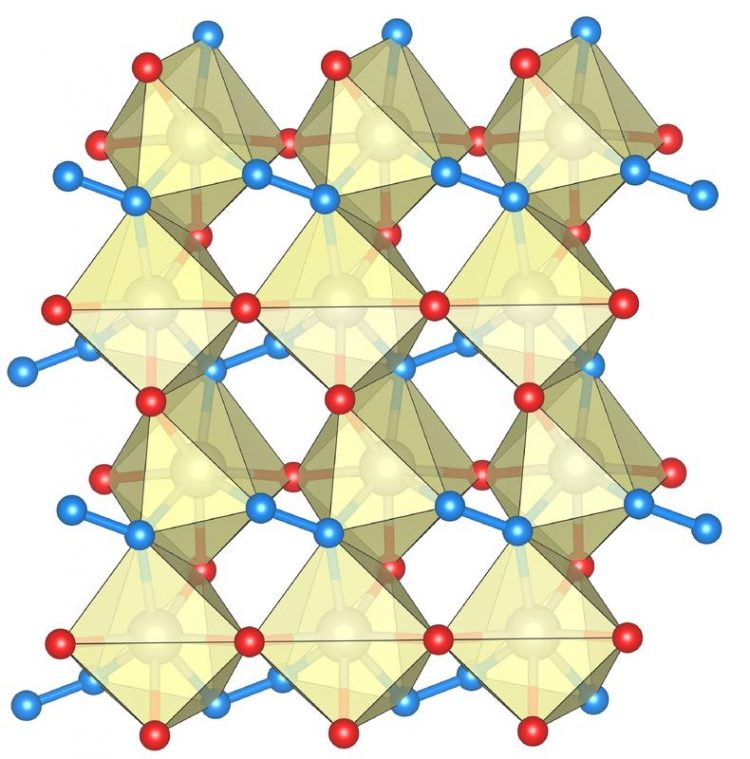Extremely hard yet metallically conductive: Bayreuth researchers develop novel material with high-tech prospects

The structure of rhenium nitride pernitride containing single nitrogen atoms (red) and N-N nitrogen dumbbells (blue). Larger balls show rhenium atoms. Illustration: Maxim Bykov
The possibility of finding a compound that was metallically conductive, super-hard, and ultra-incompressible was long considered unlikely in science. It was believed that these properties could not occur simultaneously in the same material and were therefore incompatible. But this prejudice has been soundly refuted by the research work now published, which has passed through two stages of development in Hamburg and Bayreuth:
Initially, the scientists synthesized the rhenium nitride pernitride in high-pressure experiments in a laboratory at the University of Bayreuth, and subsequently characterised it chemically and structurally at the German Electron Synchrotron (DESY). Under a compression pressure of 40 to 90 gigapascals, small amounts of this material were produced in a diamond anvil cell.
Re₂(N₂)(N)₂ is its chemical formula. “The crystal structure that we discovered in Hamburg’s synchrotron X-ray facility PETRA III surprised us very much: It contains both single nitrogen atoms and the N-N nitrogen dumbbells, in which two nitrogen atoms are strongly bound to each other.
This internal structure obviously creates a very high resistance to pressure acting on the crystals from the outside: Rhenium nitride pernitride is ultra-incompressible,” says Dr. Maxim Bykov, postdoctoral researcher at the Bavarian Research Institute of Experimental Geochemistry & Geophysics (BGI) at the University of Bayreuth.
Here at BGI it was subsequently possible to produce the new material in a large-volume press at a significantly lower pressure (33 gigapascals). “Applications of the large-volume press technology for materials synthesis are of great importance to materials science,” emphasizes Prof. Dr. Tomoo Katsura of the Bavarian Geo Institute. At the heart of the new process is a reaction of rhenium with ammonium azide.
The rhenium nitride pernitride synthesized in this way can be investigated under ambient conditions. And the process can be used for the synthesis of other nitrides, in particular nitrides of transition metals, which could also have technologically important properties. This research therefore shows in exemplary fashion just what innovation can come out of high-pressure research in materials science.
“Although the exact scope of application for the new material is still hard to grasp, its exceptional combination of physical properties makes rhenium nitride a material that can help meet the technological challenges of the future,” says Prof. Dr. Natalia Dubrovinskaia of the Laboratory of Crystallography at the University of Bayreuth.
“What is important about our new study, however, is not only the results as such, or the technological applications that might one day spring up. What is particularly exciting is that the development and synthesis of the new material contradicts and clearly disproves previous views that were firmly established in materials science. We have succeeded in doing something that, according to earlier predictions, should not have been possible at all. This should stimulate and encourage further theoretical and experimental work in the field of high-pressure material synthesis”, explains Prof. Dr. Leonid Dubrovinsky from the Bavarian Geo Institute, who coordinated the international research work together with Prof. Dr. Natalia Dubrovinskaia.
International Cooperation:
In addition to the University of Bayreuth and the German Electron Synchrotron (DESY), the Friedrich Alexander University Erlangen-Nuremberg, the Ludwig Maximilian University of Munich, the University of Linköping, the materials modelling and development laboratory in Moscow, and the European Synchrotron Radiation Facility (ESRF) in Grenoble were also involved in the research work.
Research Funding:
The research work at the University of Bayreuth was funded by the German Research Foundation (DFG) and the Federal Ministry of Education and Research (BMBF).
Dr. Maxim Bykov
Bavarian Research Institute of Experimental Geochemistry & Geophysics (BGI)
University of Bayreuth
Maxim.Bykov@uni-bayreuth.de
Prof. Dr. Leonid Dubrovinsky
Bavarian Research Institute of Experimental Geochemistry & Geophysics (BGI)
University of Bayreuth
Telephone: +49 (0)92155 -3736 or -3707
Leonid.Dubrovinsky@uni-bayreuth.de
Prof. Dr. Natalia Dubrovinskaia
Laboratory for Crystallography
University of Bayreuth
Telephone: +49 (0)92155 -3880 or -3881
Natalia.Dubrovinskaia@uni-bayreuth.de
Maxim Bykov et al.: High-pressure synthesis of ultraincompressible hard rhenium nitride pernitride Re₂(N₂)(N)₂ stable at ambient conditions. Nature Communications (2019),
DOI: http://dx.doi.org/10.1038/s41467-019-10995-3.
Media Contact
More Information:
http://www.uni-bayreuth.de/All latest news from the category: Materials Sciences
Materials management deals with the research, development, manufacturing and processing of raw and industrial materials. Key aspects here are biological and medical issues, which play an increasingly important role in this field.
innovations-report offers in-depth articles related to the development and application of materials and the structure and properties of new materials.
Newest articles

NASA: Mystery of life’s handedness deepens
The mystery of why life uses molecules with specific orientations has deepened with a NASA-funded discovery that RNA — a key molecule thought to have potentially held the instructions for…

What are the effects of historic lithium mining on water quality?
Study reveals low levels of common contaminants but high levels of other elements in waters associated with an abandoned lithium mine. Lithium ore and mining waste from a historic lithium…

Quantum-inspired design boosts efficiency of heat-to-electricity conversion
Rice engineers take unconventional route to improving thermophotovoltaic systems. Researchers at Rice University have found a new way to improve a key element of thermophotovoltaic (TPV) systems, which convert heat…



